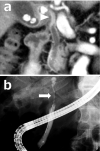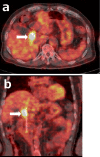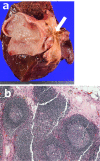A Resected Case of Follicular Cholangitis That Was Positive on 18F-fluorodeoxyglucose-positron Emission Tomography
- PMID: 32448841
- PMCID: PMC7516323
- DOI: 10.2169/internalmedicine.4611-20
A Resected Case of Follicular Cholangitis That Was Positive on 18F-fluorodeoxyglucose-positron Emission Tomography
Abstract
We experienced a case of follicular cholangitis that was positive on fluorodeoxyglucose-positron emission tomography (18F-FDG-PET). A 70-year-old man was admitted for jaundice. Endoscopic retrograde cholangiography showed stenosis of the middle to upper choledocus. 18F-FDG-PET depicted a localized hot spot at the stenotic lesion (maximum standardized uptake value = 8.2). Although no malignant findings were found in the cytology or on a bile duct biopsy, malignancy could not be excluded, so surgical treatment was performed. Follicular cholangitis is a new, rare disease that causes severe biliary stricture. Only 11 cases of follicular cholangitis have been reported, including the present case.
Keywords: 18F-FDG-PET; biliary stricture; cholangiocarcinoma; follicular cholangitis.
Conflict of interest statement
Figures




Similar articles
-
Monitoring dominant strictures in primary sclerosing cholangitis with brush cytology and FDG-PET.J Hepatol. 2014 Dec;61(6):1352-7. doi: 10.1016/j.jhep.2014.07.032. Epub 2014 Aug 9. J Hepatol. 2014. PMID: 25111173
-
Localized sclerosing cholangitis?Endoscopy. 1985 May;17(3):121-2. doi: 10.1055/s-2007-1018478. Endoscopy. 1985. PMID: 4006872
-
Significance of fluorodeoxyglucose PET imaging in the diagnosis of malignancies in patients with biliary stricture.Eur J Surg Oncol. 2005 Dec;31(10):1175-9. doi: 10.1016/j.ejso.2005.05.012. Epub 2005 Jul 12. Eur J Surg Oncol. 2005. PMID: 16019182
-
The role of (18)F-fluorodeoxyglucose positron emission tomography in the diagnosis, staging, and follow-up of cholangiocarcinoma.Surg Oncol. 2011 Mar;20(1):e10-7. doi: 10.1016/j.suronc.2009.08.003. Epub 2009 Oct 4. Surg Oncol. 2011. PMID: 19804967 Review.
-
Grade I lymphomatoid granulomatosis with increased uptake of [18F] fluorodeoxyglucose in positron emission tomography: a case report.J Clin Exp Hematop. 2009 May;49(1):39-44. doi: 10.3960/jslrt.49.39. J Clin Exp Hematop. 2009. PMID: 19474516 Review.
Cited by
-
Diagnostic Challenges in Follicular Cholangitis Mimicking Hilar Cholangiocarcinoma: A Case Report and Review of the Literature.Medicina (Kaunas). 2024 Sep 17;60(9):1513. doi: 10.3390/medicina60091513. Medicina (Kaunas). 2024. PMID: 39336554 Free PMC article. Review.
-
Follicular Cholangitis: A Rare Cause of Benign Biliary Stricture.Eur J Case Rep Intern Med. 2023 Nov 13;10(12):004152. doi: 10.12890/2023_004152. eCollection 2023. Eur J Case Rep Intern Med. 2023. PMID: 38077709 Free PMC article.
-
Follicular cholangitis mimicking a common bile duct cancer: a case report.Surg Case Rep. 2023 Jul 5;9(1):124. doi: 10.1186/s40792-023-01708-6. Surg Case Rep. 2023. PMID: 37405540 Free PMC article.
-
A case of recurrent follicular cholangitis leading to decompensated cirrhosis after left-sided hepatectomy.Clin J Gastroenterol. 2024 Aug;17(4):691-696. doi: 10.1007/s12328-024-01962-7. Epub 2024 Apr 7. Clin J Gastroenterol. 2024. PMID: 38583118
References
-
- Aoki T, Kubota K, Oka T, Hasegawa K, Hirai I, Makuuchi M. Follicular cholangitis: another cause of benign biliary stricture. Hepatogastroenterology 50: 639-642, 2003. - PubMed
-
- Lee JY, Lim JH, Lim HK. Follicular cholangitis mimicking hilar cholangiocarcinoma. Abdom Imaging 30: 744-747, 2005. - PubMed
-
- Fujita T, Kojima M, Kato Y, et al. . Clinical and histopathological study of “follicular cholangitis”: sclerosing cholangitis with prominent lymphocytic infiltration masquerading as hilar cholangiocarcinoma. Hepatol Res 40: 1239-1247, 2010. - PubMed
-
- Zen Y, Ishikawa A, Ogiso S, Heaton N, Portmann B. Follicular cholangitis and pancreatitis - clinicopathological features and differential diagnosis of an under-recognized entity. Histopathology 60: 261-269, 2012. - PubMed
-
- Fujii M, Shiode J, Niguma T, et al. . A case of follicular cholangitis mimicking hilar cholangiocarcinoma. Clin J Gastroenterol 7: 62-67, 2014. - PubMed

